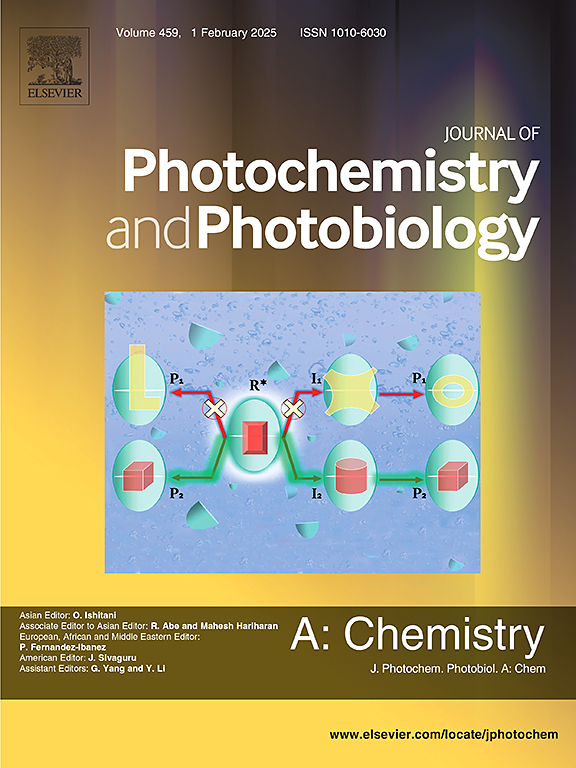脉冲激光沉积多孔二氧化钛薄膜光催化乙烯分解
IF 4.1
3区 化学
Q2 CHEMISTRY, PHYSICAL
Journal of Photochemistry and Photobiology A-chemistry
Pub Date : 2025-06-11
DOI:10.1016/j.jphotochem.2025.116568
引用次数: 0
摘要
二氧化钛(TiO2)光催化氧化具有化学稳定性好、无毒等优点,是降解乙烯的有效途径。在这项研究中,我们证明了通过脉冲激光沉积(PLD)可以在相当高的氧压力下制备纳米结构的TiO2薄膜,并评估了它们的光催化乙烯分解性能。利用扫描电子显微镜(SEM)、灰度分析和拉曼光谱分析了薄膜的结构和形态特征。结果表明,在沉积过程中,光催化效率与氧压密切相关。扫描电镜和拉曼光谱分析证实,在20 Pa及以上的氧压力下形成了多孔TiO2纳米结构,显著增加了活性表面积。随后的煅烧提高了结晶度,形成了稳定的锐钛矿相,增强了电荷分离,从而提高了光催化性能。这些发现表明PLD是一种有效的制备tio2基光催化剂的方法,可以通过可调谐的纳米结构来优化沉积参数,从而提高气相光催化效率。本文章由计算机程序翻译,如有差异,请以英文原文为准。

Photocatalytic ethylene decomposition using porous titania thin film formed by pulsed laser deposition
Photocatalytic oxidation using titanium dioxide (TiO2) is an effective approach for ethylene degradation due to its chemical stability and non-toxicity. In this study, we show that nanostructured TiO2 thin films can be fabricated via pulsed laser deposition (PLD) under rather high oxygen pressures, and their photocatalytic ethylene decomposition performance was evaluated. The structural and morphological characteristics of the thin films were analyzed using scanning electron microscopy (SEM), grayscale analysis, and Raman spectroscopy. The results indicate a strong dependence of photocatalytic efficiency on the oxygen pressure during the deposition process. SEM and Raman spectroscopy analyses confirm that porous TiO2 nanostructures were formed at oxygen pressures of 20 Pa and above, significantly increasing the active surface area. Subsequent calcination improved the crystallinity, resulting in a stable anatase phase and enhanced charge separation, thereby improving photocatalytic performance. These findings demonstrate that PLD is an effective method for fabricating TiO2-based photocatalysts, enabling the optimization of deposition parameters through tunable nanostructures to enhance gas-phase photocatalytic efficiency.
求助全文
通过发布文献求助,成功后即可免费获取论文全文。
去求助
来源期刊
CiteScore
7.90
自引率
7.00%
发文量
580
审稿时长
48 days
期刊介绍:
JPPA publishes the results of fundamental studies on all aspects of chemical phenomena induced by interactions between light and molecules/matter of all kinds.
All systems capable of being described at the molecular or integrated multimolecular level are appropriate for the journal. This includes all molecular chemical species as well as biomolecular, supramolecular, polymer and other macromolecular systems, as well as solid state photochemistry. In addition, the journal publishes studies of semiconductor and other photoactive organic and inorganic materials, photocatalysis (organic, inorganic, supramolecular and superconductor).
The scope includes condensed and gas phase photochemistry, as well as synchrotron radiation chemistry. A broad range of processes and techniques in photochemistry are covered such as light induced energy, electron and proton transfer; nonlinear photochemical behavior; mechanistic investigation of photochemical reactions and identification of the products of photochemical reactions; quantum yield determinations and measurements of rate constants for primary and secondary photochemical processes; steady-state and time-resolved emission, ultrafast spectroscopic methods, single molecule spectroscopy, time resolved X-ray diffraction, luminescence microscopy, and scattering spectroscopy applied to photochemistry. Papers in emerging and applied areas such as luminescent sensors, electroluminescence, solar energy conversion, atmospheric photochemistry, environmental remediation, and related photocatalytic chemistry are also welcome.

 求助内容:
求助内容: 应助结果提醒方式:
应助结果提醒方式:


